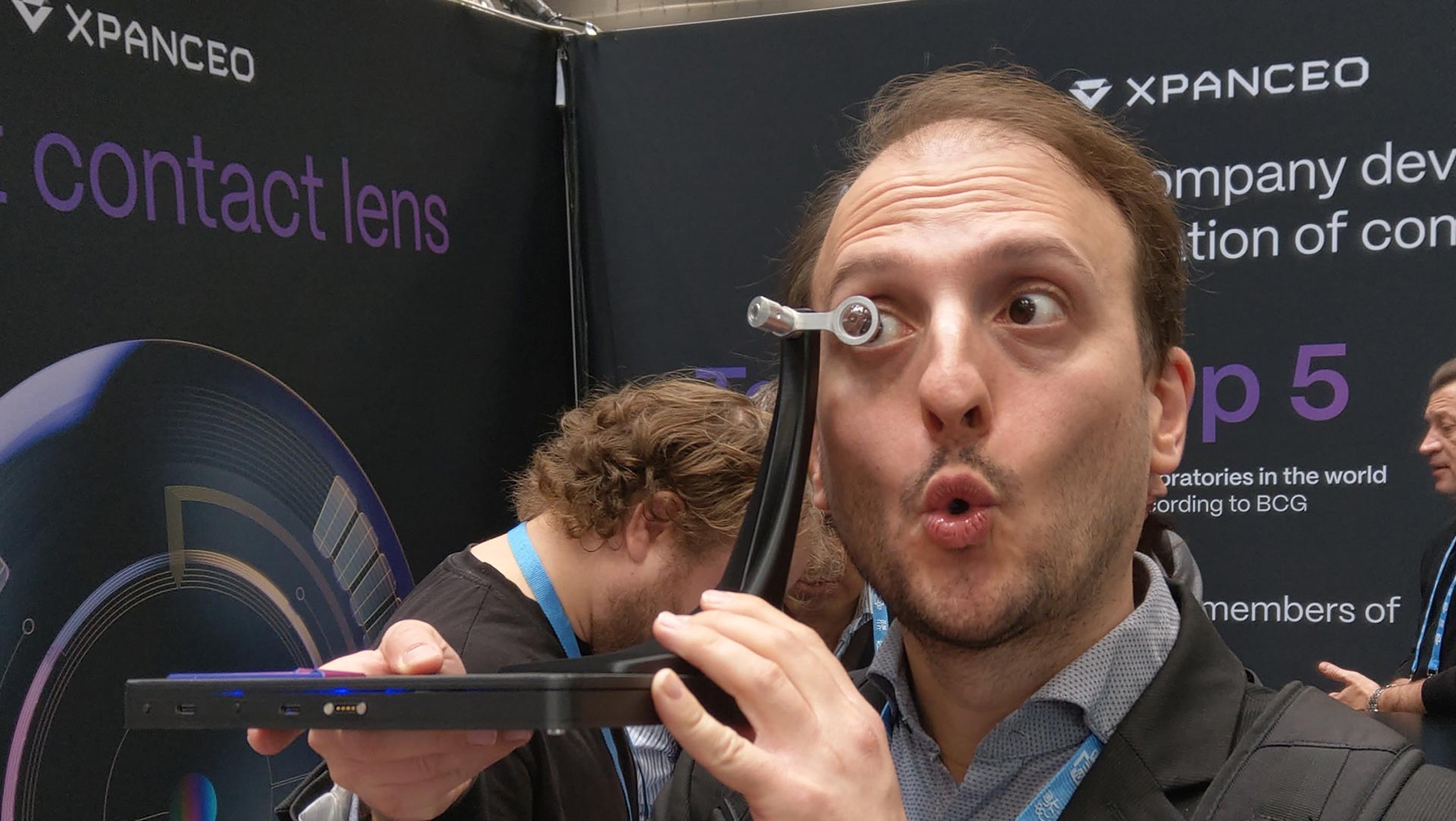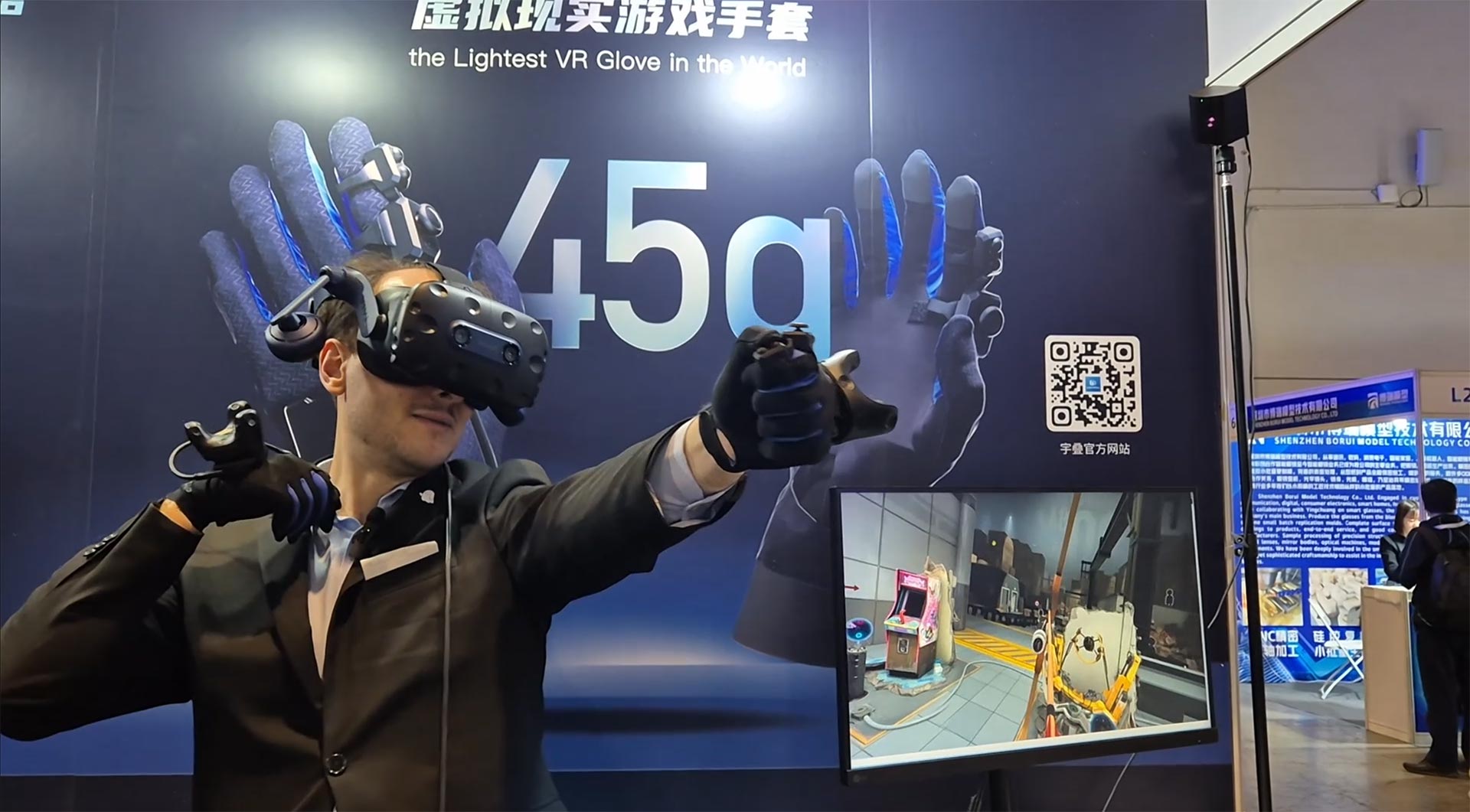XPANCEO smart contact lenses hands-on: AR prototypes from the future
At AWE, XPANCEO, a Dubai-based company working on smart contact lenses, showcased a few interesting prototypes of its futuristic technology. I was able to even put my eyes close to one of them and I want to tell you everything about this experience!
XPANCEO
If you’re not new to this space, you will surely remember Mojo Vision, an incredible company based in the US that was working on smart contact lenses. Unluckily, after having reached incredible milestones, like having their CEO putting a smart lens inside his eyes, the company pivoted to manufacturing microdisplays.

The dream of having smart contact lenses seemed to vanish, but a new startup called XPANCEO came to the rescue. Based in Dubai, it was founded by two Eastern European guys: Roman Axelrod, a serial entrepreneur, and Valentyn S Volkov, a renowned scientist. Together they joined forces with the mission of creating smart and AR contact lenses.
I interviewed the founders of XPANCEO a few months ago, and they gave me a virtual tour of their laboratory in Dubai. From my remote tour, I had the impression that these guys seriously have the skills to be able to deliver what they have in mind. Differently than Mojo, though, they don’t have a clear roadmap in mind, yet. They are experimenting with different approaches to this hard problem, creating many different prototypes until they understand which is the best way to fulfill their vision. XPANCEO claims to be on track to unveil a fully functional smart contact lens prototype by the end of 2026.
At AWE, XPANCEO was showcasing a few prototypes, and for the first time, also a smart lens in which you could put your eye in.
XPANCEO smart contact lens hands-on
The most exciting moment for me at the booth of XPANCEO, apart from meeting in person Roman and Valentyn, was putting my eyes inside a contact lens made by the company. Exactly like with Mojo Vision, people couldn’t put the lenses inside their eyes, for evident safety reasons. But it was possible to grab the demo unit and put it close to the eye so that to see some visuals inside. And this was already fantastic.

Every time I try some smart contact lens, the magic is always the same: I see it from the outside and it just seems like a normal small contact lens. Then I put it very close to the eye, I start seeing some visuals in it, and I am like WOWOWOW, THIS IS THE FUTURE. It is always very magical and very cyberpunk.
The demo unit was a hard plastic lens having a holographic display. There was an external light source in the handle of the demo device which was emitting the light in a certain way, and the lens, thanks to its holographic display, was letting me see the imagery that I was intended to see. When I put my eyes inside it, after I managed to focus on it, I was able to see some monochrome green writings, something like a simple video emulating the menu of an application that was in use. The imagery was very simple, we are not talking about the menu of the iPhone, more like the menu of a home video game in the 80s: green straight lines and texts.
The visuals I could see were defined enough to see the menus and read the texts. I have the sensation that Mojo Vision had better clarity, though, because I remember crisper texts.
The FOV of the XPANCEO lens was also very limited, so I could barely see a little portion of the menu interface. According to the press release I received after I visited the booth, the lens has a 30° FOV, but I can tell you that the perceived one was less. One of the reasons is that these lenses are made to show full FOV when they are worn on the eye, but of course, I could not do this test, so my perceived FOV with the lens close to the eye was probably just in the range 10-20°.

It’s crazy that this is possible with a power consumption of just 1-3 microwatts. I mean, actually, it’s crazy that something like this is just even possible.
Other XPANCEO prototypes
The demo lens I tried is a new prototype that the company has brought to AWE and that is called “Smart Contact Lens for AR Vision”. As I’ve said, the company is working on many possible prototypes, and some of them were showcased inside some display cases in the booth.

One of the other prototypes showcased was the “Smart Contact Lens with Transparent Electronics”, which was another hard lens that featured of course some transparent electronic components, plus in the middle a one-pixel display. All of this was made possible by XPANCEO’s patent-pending ultra-thin transparent and flexible gold conductors. Valentyn Volkov explained to us that this prototype is closer to what Mojo Vision was doing, that is it has a microdisplay in the middle. He told us that this is a clear example of the experimentation stage the company is in: for the display of the lens they are trying different approaches, both the holographic display of the lens I put my eyes in and the “standard” microdisplay of this prototype.

The “Smart Contact Lens for Data Reading” was instead a demonstration of “wireless data transmission capabilities integrated directly into the lens, enabling real-time interaction with data and the ability to receive information, such as biometric data, from embedded sensors” (Yes, I copied this sentence from the press release). The lens integrated some NFC technology and it was possible to put your phone close to it so that the lens made it go to DuckDuckGo and search for “XPANCEO”. I jokingly asked Valentyn if this was the future of the promotion of my blog: in the future, when I meet people at exhibitions, I randomly ask them to smash a phone into my eye to make them go to my website (I would become blind, but at least I would avoid the pain of spelling “skarredghost” all the times…). He explained to me that the NFC thing is of course a toy interaction for exhibitions to make visitors of the booth amused and the data transmission interactions imagined for the future are actually different.

The last prototype highlighted in the booth was its “Contact Lens with Intraocular Pressure (IOP) Sensor”. This lens featured a small square which was a sensor for intraocular pressure, which is an important parameter for the early detection of glaucoma. This sensor installed directly on the eye can constantly monitor IOP with great accuracy, and if this data is collected e.g. by a smartphone, it could be used to detect some possible health issues before it is too late. What was amazing about this lens is that it was not a hard lens, but a soft hydrogel one. This is relevant because many people who wear contact lenses every day don’t wear hard plastic lenses, but this kind of soft ones. So if XPANCEO manages to install its technology into soft lenses, it could really pave the way to the future of technology. This is an edge the company has over Mojo Vision, which only operated on hard scleral lenses.

Final considerations

I’m a big fan of smart contact lenses and at the booth of XPANCEO, I looked like a little kid inside Santa Claus’s village. It was very interesting to see the different prototypes the company is working on, and especially it was magical to put my eyes inside one of them. There is still a lot of work to do to have commercially available smart contact lenses, but it is great to see that there are already tangible experiments in this sense. XPANCEO is proving with these showcases that they have the capability of actually delivering something interesting.
The dream of having smart contact lenses in this decade is one we can have with our eyes opened…
Disclaimer: this blog contains advertisement and affiliate links to sustain itself. If you click on an affiliate link, I'll be very happy because I'll earn a small commission on your purchase. You can find my boring full disclosure here.



